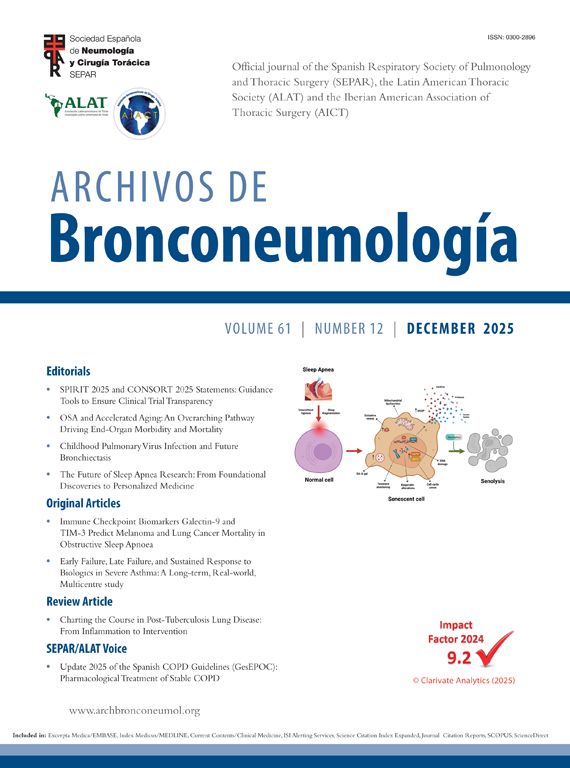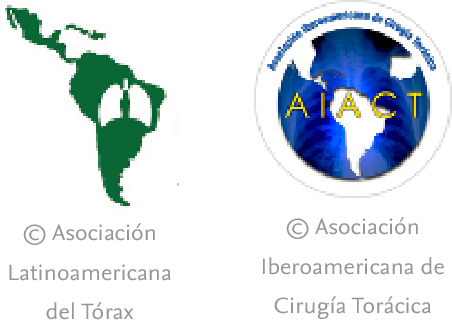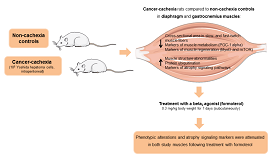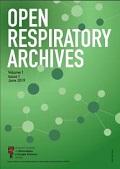Biomarkers have been described as characteristics that can be objectively measured and evaluated as indicators of normal biological processes, pathogenic processes, or pharmacologic responses to a therapeutic intervention. Biomarkers have been shown to have clinical utility for improving the diagnosis, treatment options and prognosis of patients. In respiratory medicine, molecular biomarkers have contributed to the comprehensive clinical management of diseases (e.g., circulating biomolecules and the expression of certain genes), and many biomarkers are either currently in use or under investigation. Some of the most important contributions of biomarkers to respiratory medicine are elevated levels of fibrinogen, C-reactive protein, and leukocyte count, which have been found to be associated with an increased risk of exacerbations in chronic obstructive pulmonary disease (COPD) patients.1 Similarly, assessing procalcitonin levels may help distinguish lower respiratory tract infections induced by bacteria from those that are not induced by bacteria, thereby preventing unnecessary antibiotic treatments.2 Sputum eosinophilia can be useful for determining asthma endotype or phenotype. Although a multitude of potential biomarkers for the personalized management of respiratory pathologies have been explored, not all have been found to be useful. Ideally, a biomarker must fulfill several requirements to be deemed useful. Mainly, it needs to be specific to the condition or disease being evaluated, available through minimally invasive means, quantitatively related to the extent of exposure, and cost-effective to assay. It is unusual for a single biomarker to meet all these requirements. In clinical practice, it is common to combine several biomarkers to diagnosis a disease, and give a prognosis, and predict response to a certain treatment. Therefore, in precision medicine, the best strategy would be to use a combination of biomarkers that can perform all these functions and are specific to the disease being evaluated. In summary, there is a need for further research into different biomarkers and their combinations to improve personalized medicine.
MicroRNAs (miRNAs) are noncoding RNA molecules with lengths ranging from 19 to 25 nucleotides that have been implicated in many biological processes. miRNA dysregulation is widely involved in the pathophysiological processes of human diseases and has been identified as a promising biomarker. These molecules function as posttranscriptional regulators. The function of miRNAs begins with their binding to the target mRNA and repressing its translation or marking it for degradation. The fact that their levels have been found to be dysregulated in several pathologies and even in response to treatments, as well as the fact that they are present in samples obtainable through liquid biopsies3 makes them very attractive candidates as potential biomarkers. Previous studies have explored the potential of miRNAs as biomarkers in different pathologies. Regarding lung cancer, miR-20a, miR-10b, miR-150 and miR-223 have been proposed as potential biomarkers for non-small cell lung cancer, and miR-205 has been proposed as a potential biomarker for squamous cell carcinoma.4 Another study evaluating miR-7a methylation levels in chronic obstructive pulmonary disease (COPD) patients found higher levels of methylation in COPD patients with the emphysema phenotype, who are generally at a higher risk of suffering lung cancer.5 Interestingly, altered levels of miR-320b, miR-22-3p and miR-423-5p have been reported in extracellular vesicles isolated from bronchoalveolar fluid lavage (BAL) of COPD patients compared to healthy nonsmokers. Moreover, miR-100-5p expression differs between healthy smokers and COPD patients.6 Extracellular vesicles isolated from BAL have also been used to perform similar studies in patients with lung sarcoidosis, with levels of miR-150 and miR-146a being upregulated in patients with parenchymal involvement (stage II) compared to patients with bilateral hilar lymphadenopathy only (stage I).7 In childhood asthma patients, miR-155-5p and miR-532-5p have been associated with lung function recovery in response to inhaled corticosteroids.8 The heterogeneity of asthma causes treatment outcomes to differ, thus increasing the need for biomarkers that can discern between different endotypes and predict and monitor treatment. A study explored miRNA expression in extracellular vesicles isolated from obese patients with obstructive sleep apnea (OSA) and obese hypoventilation syndrome, and found that vesicles isolated from these patients could induce endothelial dysfunction in vitro. This effect was no longer observed when extracellular vesicles were isolated from the same patients after receiving continuous positive airway pressure (CPAP) therapy. The same study reported changes in miRNA (miR-16-5p, miR-4459, miR-451a and miR-6510-5p) levels after treatment with CPAP.9 Another study showed the predictive capabilities of three miRNAs (miR-378a-3p, miR-486-5p, and miR-100-5p) to predict favorable blood pressure responses to CPAP therapy in patients with resistant hypertension and OSA.10 Since OSA patients are at increased risk of cardiovascular disease, miRNAs could help predict adequate response to CPAP therapy and identify OSA patients who could benefit from such treatment. Levels of miR-328 were found to be upregulated in a rat model of pulmonary fibrosis. The silencing of miR-328 was also found to alleviate the progression of pulmonary fibrosis. Interestingly, the same study found that miR-328 directly targets and inhibits FAM13A, a gene whose polymorphisms are known to be associated with prognosis in idiopathic pulmonary fibrosis.11 If these findings were replicated in humans, levels of rno-miR-328's ortholog could potentially be used to monitor disease progression and perhaps even treatment response. Of note, the existence of a miRNA-based signature that could improve risk stratification in patients with COVID-19 has been reported. This signature consists of 4 blood miRNAs (miR-16-5p, miR-192-5p, miR-323a-3p and miR-451a) that predict mortality in early-in-ICU patients with COVID-19.12 miRNA screening has also been combined with machine learning approaches for biomarker discovery. Using four different machine learning models in combination with the miRNA profiling of pulmonary hypertension patients, a study managed to screen out two miRNAs (miR-636 and miR-187-5p) able to diagnose the condition with high accuracy.13 Likewise, analysis through machine learning of miRNA content isolated from extracellular vesicles identified subjects at risk of accelerated lung function decline.14
Overall, research on miRNAs and their potential as biomarkers has gained traction over the past decade. The examples presented here are summarized in Table 1. Many studies have shown how miRNA levels vary in different pathologies or in response to treatment. Nonetheless, further research is needed to fully exploit their role as biomarkers. If the mechanisms through which miRNAs are involved in pathophysiological processes are unknown and the identified miRNA signatures in these studies are not validated in large enough and independent cohorts, it could lead to incorrect interpretations.
Summary of publications studying the potential of miRNAs in several respiratory diseases.
| Reference | Title | Publication year | Experimental design | Sample source | Sample size | Pathology/disease | Main findings |
|---|---|---|---|---|---|---|---|
| Rosas-Alonso R. et al.5 | Hypermethylation of anti-oncogenic microRNA 7 is increased in emphysema patients. | 2023 | Differences in miR-7 methylation levels between smokers without airflow limitations and between COPD patients classified into emphysema, frequent exacerbators, bronchitis and asthma overlap | Buccal epithelial swabs | 30 smokers without airflow limitation and 136 COPD patients | Emphysema and lung cancer | Increased levels of miR-7 methylation in COPD patients with emphysema when compared to smokers without airflow limitation or other COPD patients. |
| Kaur G. et al.6 | Distinct exosomal miRNA profiles from BALF and lung tissue of COPD and IPF patients. | 2021 | Differences in lung tissue derived or BALF exosomes miRNA profile between non-smokers, healthy smokers, COPD and IPF patients | BALF and lung tissue exosomes | 8 non-smokers, 8 smokers, 16 COPD patients and 8 IPF patients | Chronic Obstructive Pulmonary disease and Idiopathic Pulmonary Fibrosis | Smoking status alone does not appear to induce differences in exosome miRNAs content. Distinct miRNA profile was detected in exosomes from BALF or lung derived tissue when comparing healthy non-smokers to COPD patients, healthy non-smokers to IPF patients and COPD patients to IPF patients. |
| Kishore A. et al.7 | Expression analysis of extracellular microRNA in bronchoalveolar lavage fluid from patients with pulmonary sarcoidosis. | 2018 | Differences in BAL exosomal miRNA content between pulmonary sarcoidosis stage I and stage II patients | BALF EVs | 16 stage I pulmonary sarcoidosis patients and 17 stage II pulmonary sarcoidosis patients | Pulmonary sarcoidosis | Detected upregulation of two miRNAs, miR-146a and miR-150, in stage II patients over stage I patients. The expression of these two miRNAs correlated negatively to pulmonary function in sarcoidosis patients. |
| Li J. et al.8 | Circulating microRNAs and treatment response in childhood asthma. | 2020 | Differences in miRNA profiles of asthma patients that respond to inhaled corticosteroids respective of those who do not | Serum | 462 children with asthma | Asthma | Found hsa-miR-155-5p and hsa-miR-532-5p to be correlated to lung function for subjects on inhaled corticosteroids. The former appeared to be positively correlated whereas the latter negatively. |
| Bhattacharjee R. et al.9 | Exosomal cargo properties, endothelial function and treatment of obesity hypoventilation syndrome: a proof of concept study. | 2018 | Differences in patients with OHS and OSA before and after receiving CPAP | Plasma EVs | 12 patients with OHS and OSA | Obesity Hypoventilation Syndrome and Obstructive Sleep Apnea | Exosomes of OSA and OHS patients are capable of inducing in vitro endothelial dysfunction. The induction of endothelial dysfunction by these patient's exosomes is reversible on treatment with CPAP. Differential expression of 4 miRNAs (hsa-miR-16-5p, has-miR-4459, has-miR-451a and has-miR-6510-5p) in patient's exosomal cargo before and after CPAP treatment. |
| Sánchez-De-La-Torre M. et al.10 | Medicine in patients with resistant hypertension and obstructive sleep apnea: blood pressure response to continuous positive airway pressure treatment. | 2015 | Differences in circulating miRNA profiles of resistant hypertension patients with OSA treated with CPAP that responded to therapy versus those who did not | Plasma | 71 resistant hypertension patients with OSA treated with CPAP | Obstructive Sleep Apnea | The study could identify a cluster of miRNAs related to cardiovascular functions able to predict favorable BP responses to CPAP therapy in resistant hypertension patients with OSA. |
| Yao M.Y. et al.11 | microRNA-328 in exosomes derived from M2 macrophages exerts a promotive effect on the progression of pulmonary fibrosis via FAM13A in a rat model. | 2019 | In vivo and in vitro exposure of rats and rat derived primary cell culture to miR-328 overloaded exosomes | – | – | Pulmonary Fibrosis | Upregulation of miR-328 and downregulation of FAM13A was observed in pulmonary fibrosis rat models. Interaction with FAM13A and miR-328 was confirmed. miR-328 was suggested to induce pulmonary fibroblast proliferation through FAM13A silencing. |
| de Gonzalo-Calvo D. et al.12 | A blood microRNA classifier for the prediction of ICU mortality in COVID-19 patients: a multicenter validation study. | 2023 | miRNA profile screening of critically ill COVID-19 patients admitted to the ICU | Plasma | 503 COVID-19 patients | COVID-19 | A miRNA signature comprised of miR-16-5p, miR-192-5p, miR-323a-3p and miR-451a was validated as an all-cause-mortality predictor in critically ill COVID-19 patients. |
| Errington N. et al.13 | A diagnostic miRNA signature for pulmonary arterial hypertension using a consensus machine learning approach. | 2021 | miRNA profile screening of pulmonary hypertension patients combined with 4 different machine learning algorithms. | Plasma | 64 treatment naïve pulmonary hypertension patients and 43 disease and healthy controls | Pulmonary hypertension | miR-636 and miR-187-5p were found to be good predictors of pulmonary hypertension by the four machine learning algorithms used in the study. |
| Eckhardt C.M. et al.14 | Extracellular vesicle-encapsulated microRNAs as novel biomarkers of lung health. | 2023 | miRNA profile screening of subjects who had lung function tests performed over them | Plasma EVs | 656 participants | Lung function decline | EV-miRNA expression patterns could help early prediction of subjects at risk of lung function decline. |
Acronyms: BALF=BAL=bronchoalveolar lavage fluid, CPAP=continuous airway positive pressure, COPD=chronic obstructive pulmonary disease, EVs=extracellular vesicles, ICU=intensive care unit, IPF=idiopathic pulmonary fibrosis, OHS=obesity hypoventilation syndrome, OSA=obstructive sleep apnea, miRNA=microRNA.
Combining miRNA profiling with innovative artificial intelligence-based tools will accelerate biomarker discovery considerably. Remarkably, artificial intelligence-based systems may have the greatest impact in the implementation of biomarkers in clinical prognosis and prediction.15
FundingInstituto de Salud Carlos III (ISCIII) (PI22/00636), co-funded by the European Union. MS has received financial support from “Ministerio de Ciencia e Innovación – Agencia Estatal de Investigación” (Ramón y Cajal: RYC2019-027831-I). DdGC has received financial support from Instituto de Salud Carlos III (Miguel Servet 2020: CP20/00041) co-funded by the European Union.
Conflict of interestsThe authors state that they have no conflict of interests.










